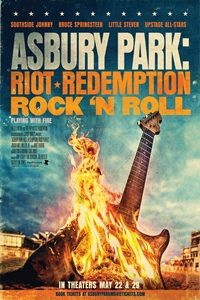
Great documentary with a guest appearance by Delray’s own Max Weinberg.
We went to Ipic last week to see a new documentary Asbury Park: Riot, Redemption, Rock n’ Roll.
Nestled in our cozy “pod” with a pillow, blanket and a glass of wine after a long day, it would have been tempting to nod off but the movie grabbed us from the opening frame and held us through the mini concert at the end.
Having been to Asbury Park last summer it was extra interesting because we recognized streets, buildings and iconic landmarks.
Asbury Park—all of one square mile—looms large in our national consciousness because of its history and musical roots. This little town punches far above its weight.
In the 60s, the place crackled with amazing music. All of the big acts—The Stones, Hendrix, The Who, The Byrds—played the convention hall sometimes on the same bill all for $5 a ticket.
Can you imagine?
But just as compelling was the local music scene with clubs like the Upstage, The Stone Pony and the Wonder Bar attracting local legends such as Bruce Springsteen, Miami Steve Van Zandt and Southside Johnny.
It was a special and magical time that came to a crashing end with the riots of July 1970.
The redemption comes later, with the redevelopment of Asbury again driven in large part driven by music.
It’s a great story. And if you love cities and music this is a must see film.
I’ve been thinking about the documentary ever since and the instant attachment I felt to the area when we visited. I’m a Springsteen fanatic and to walk the boardwalk and see the sights that inspired my favorite songwriter was a real thrill.
As a student of cities, I also admire how Asbury leveraged its strengths and brand to launch an impressive comeback.
The riots took a huge toll on the town’s economy and soul and was sparked by racial tensions that seethed between east Asbury and the west side of town. Because despite the vibrant music scene and the throngs of tourists who were flocking to the shore the people on the west side of town were lacking jobs, quality housing and recreational opportunities. Tensions may build slowly, but when they explode the impacts can last years. In Asbury’s case, the damage caused by the riots lasted decades.
The documentary confronts the issues head on and also shows the terrible toll that violence, inequality, racism and poverty takes on a town until one day, sparked by something minor it all unravels.
There are lessons there.
Springsteen, sitting in the ruins of a former club where he played, talks about the riots as something that perhaps “had to happen.”
Maybe, I suppose.
But isn’t it sad that things have to boil over into violence and destruction before people eventually focus on what needs to be done.
The movie praises Asbury Park for its redemption and seems to strongly indicate that things are different today with care being taken to avoid and or confront some of the mistakes of the past and not repeat them.
I don’t know enough about Asbury to know whether that’s true. But it does seem that once again music is leading the way—with schools focused on bringing east and west together through music and the Asbury Film and Music Festival positioned as a major cultural force that bring tourist dollars back to town.
We loved our stay in Asbury—the restaurants were awesome, the music scene was lively and the beach was beautiful. So were the neighborhoods which seems to be attracting urban pioneers and creatives.
If you’re in the area, visit. The Jersey Shore is a lot more than Snooki and “The Situation.”
It’s a place of magical history, enduring music and cultural importance. If you can’t, check out the documentary it’s special.
Speak Your Mind